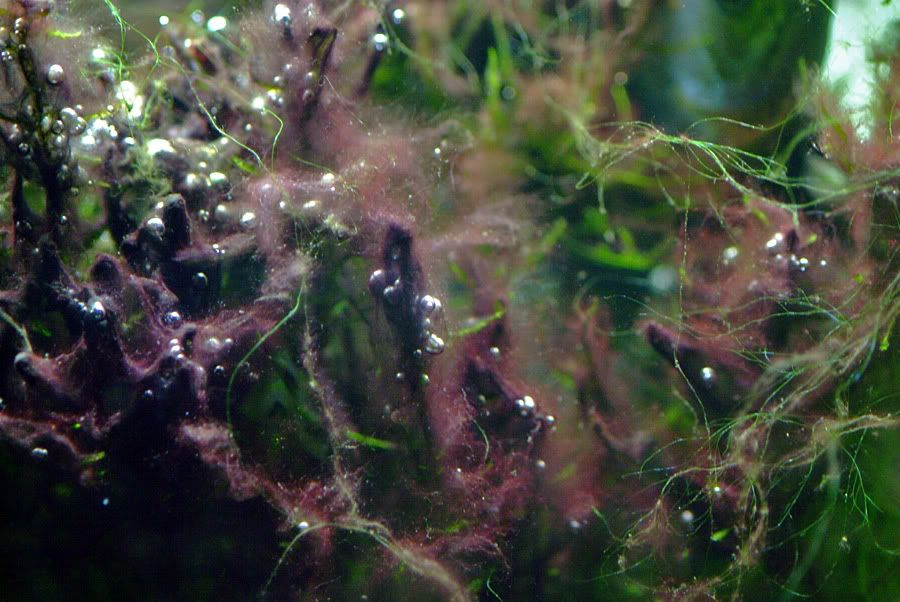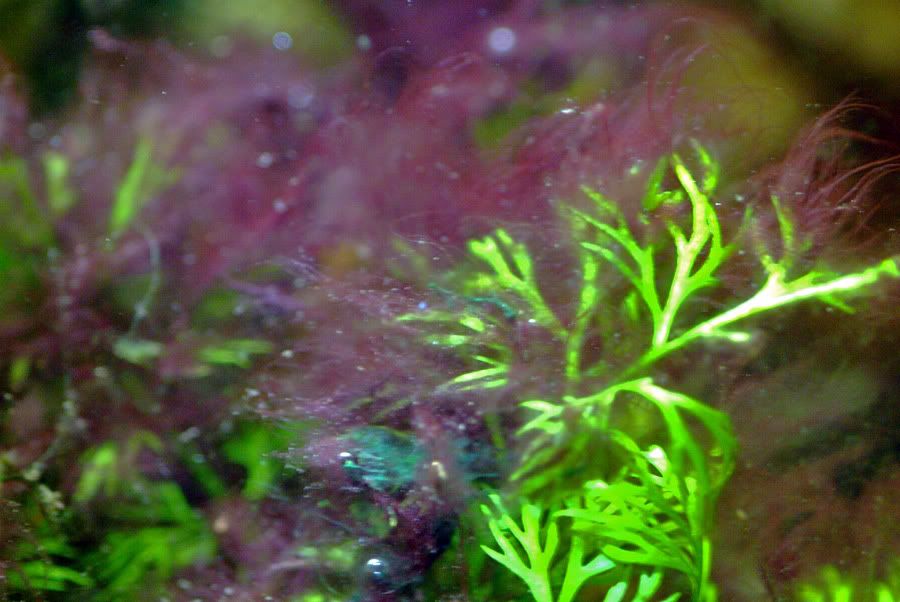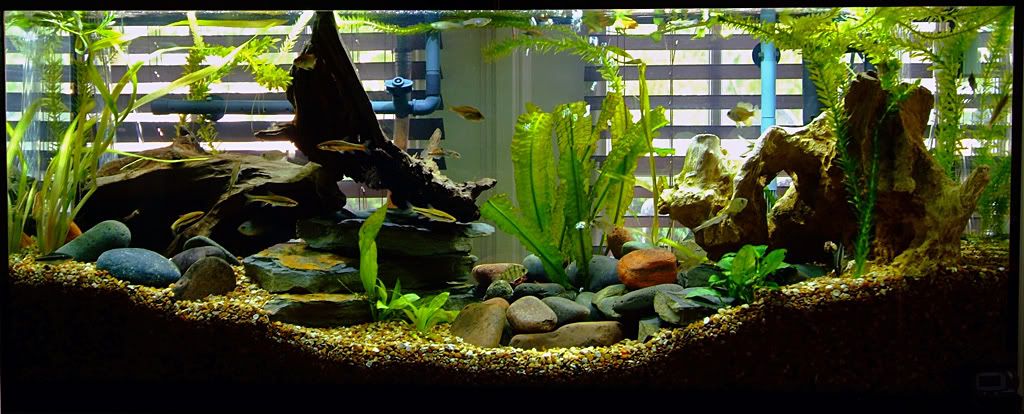Fish disease affecting shiners
#41
 Guest_gerald_*
Guest_gerald_*
Posted 09 May 2012 - 10:15 AM
I also doubt that a small fish dying in a large, well-established tank would cause significant ammonia, especially while the fish were not being fed.
Congrats to you both on becoming parents !!!
#42
 Guest_Usil_*
Guest_Usil_*
Posted 09 May 2012 - 10:16 AM
Also, I got one of those strong magnet tank cleaners, the scrubber one stays inside the tank and the outside one on the outside tank, and I use these once a week all over the glass. This regime is working.
Here are before shots:



Here is the after shot - after the cleaning and 4 months later:

Usil
Edited by Usil, 09 May 2012 - 10:34 AM.
#43
 Guest_jblaylock_*
Guest_jblaylock_*
Posted 09 May 2012 - 10:57 AM
I doubt they died of starvation -- five days is not long enough for that, except maybe the ones that were already "dwindling". Old fish are especially prone to Mycobacterium, if that's what's going on in your tank. I think of Myco as an "experienced fish keeper's problem" because the people who see it most are those who have learned how to avoid or cure all the common diseases and WQ problems that kill fish quickly, and can keep fish alive for many years.
I also doubt that a small fish dying in a large, well-established tank would cause significant ammonia, especially while the fish were not being fed.
Congrats to you both on becoming parents !!!
Erica: I checked Ammonia, 0ppm. Nitrate was around 20ppm, and Nitrite was 0. Since the fish death I have done a water change.
Usil: I considered getting a couple siamese algae eaters, but read there are aggressive, how do they do with your fish?
Gerald: Thank you, we are both proud parents!
I think 5 days wouldn't cause starvation on otherwise healthy fish. Actually, I fed them Monday before we went to the hospital and they were already dead on Friday so it was really 3 days. What can I do about the Myco problem I seem to be having? I have beefed up my fitration since the problem began, and if the H2O2 did killoff my beneficial bacteria, I have stopped using that but I realize it could take some time to build the bacteria back up strong. Is there anything else I can do? Should I treat for general bacteria problems, if so, how should I go about it. I've been using more salt and Melafix, but it doesn't seem to be helping. Would any particular medication help?
#44
 Guest_EricaWieser_*
Guest_EricaWieser_*
Posted 09 May 2012 - 11:29 AM
I've had Mycobacterium marinum curved spine symptoms in my aquariums a few times. The first time my tank looked like this:What can I do about the Myco problem I seem to be having?
youtube.com/watch?v=yjmeo46nBa4
I had babysitted a friend's mycobacterium infected tank over vacation and his airstone vaporized the mycobacterium. Its aerosolized particles made it the few feet to my tank. That's the only explanation I can come up with for how my system got infected, because I didn't use the same net or exchange water between the two tanks.
My levels were all great (ammonia, nitrite, nitrate, stable pH), but I found out later that if you have the water too hot Xiphophorus montezumae are very susceptible to disease. At five and eight seconds into that video you can see one repeatedly itch itself against the stick.
So I bought Furan 2. drsfostersmith.com/product/prod_display.cfm?pcatid=4827 It was, for me at the time, very expensive. So I bought enough to dose the entire 55 gallon tank. But I was stupid, because it turns out the instructions say to dose the tank several times, and I only had bought enough for one dose. It killed all the plants and saved none of the fish. The only things that remained was the cladophora, which mutated into this strange fast growing, medication resistant version of itself. I tried to make the best of it:
youtube.com/watch?v=8y8b9lxctMc
But my tank was still infected with mycobacterium. Six months and two complete tank breakdowns and setups later, the wild color strain of swordtails that I got was very susceptible to it:
youtube.com/watch?v=8zmjBRd7Qkg
You can see the one female with the curved spine in that video.
At that point I had tried antibiotics (not very well), had tried breaking down the tank, driving it for an hour on the highway in the back of a truck, and setting it back up twice, had tried keeping the water pristine at all times. The mycobacterium was not going away.
So. I finished my breeding program and got the phenotype that I wanted to see from the swordtails. Then I sold them all off, put kitty litter in the bottom of the tank, planted it, and filled it with Elassoma gilberti. Some fish are susceptible to mycobacterium (Xiphophorus montezumae) and some fish have never ever shown a symptom of it (Elassoma gilberti). I changed fish, and the disease went away. There was a final exam yesterday morning that I was studying for, and as I was going over some of the lecture material one of the questions one of my professors asked stood out to me. When you're studying pathology and you're looking at a dead animal that died from some pathogen, don't forget to ask, "Why this host?" Why swordtails and not Elassoma? Not a single Elassoma has ever shown symptoms. The pet store color strain also didn't contract it much, while it killed every single X. montezumae in the tank. I honestly couldn't tell you why. But anyway, that's my saga of 'Erica and the mycobacterium'. That's the advice I have to offer: Buy enough medication to use multiple doses, be prepared for Furan 2 to kill your plants, and don't baby sit people's infected tanks by putting them in the same room with your tank (or at least take the airstone out first).
Edited by EricaWieser, 09 May 2012 - 11:37 AM.
#45
 Guest_EricaWieser_*
Guest_EricaWieser_*
Posted 09 May 2012 - 11:36 AM
Your ammonia and nitrite are at 0 ppm and your nitrate is at nonzero ppm. Your tank is cycled and your beneficial bacteria are at a healthily high number. They are already built back up strong.I have beefed up my fitration since the problem began, and if the H2O2 did killoff my beneficial bacteria, I have stopped using that but I realize it could take some time to build the bacteria back up strong.
#46
 Guest_jblaylock_*
Guest_jblaylock_*
Posted 09 May 2012 - 01:11 PM
Check this link, ever used those medications listed? Worth a shot?
#47
 Guest_Usil_*
Guest_Usil_*
Posted 09 May 2012 - 01:48 PM
Usil
Edited by Usil, 09 May 2012 - 01:54 PM.
#48
 Guest_gerald_*
Guest_gerald_*
Posted 09 May 2012 - 02:12 PM
I did try Kanamycin on some Laetacara curviceps (cichlids) in the 1980s and they lived several months and bred successfully (with gaping sores and barely functional jaws). They did not visibly improve, but they did take much longer to die than I expected, and their fry appeared healthy (I removed fry just after hatching) so maybe it did slow the progression. However, I did not keep up long-term dosing like Strohmeyer recommends. Antibiotics are a double-edged sword, since Myco is one of the hardest bacteria to kill, so antibiotics are probably destroying all the fish's natural intestinal bacteria as well as the beneficial bacteria in the tank & filter.
#49
 Guest_EricaWieser_*
Guest_EricaWieser_*
Posted 09 May 2012 - 02:29 PM
I have never used Kanamycin, Neomycin, or Isoniazid, and have no experience with them.http://www.aquarium-...berculosis.html
Check this link, ever used those medications listed? Worth a shot?
My fish didn't really have lesions. The symptom they had was curved spines. Dramatically developing curving spines in adults. And itching.
Edited by EricaWieser, 09 May 2012 - 02:33 PM.
#50
 Guest_jblaylock_*
Guest_jblaylock_*
Posted 09 May 2012 - 02:35 PM
#51
 Guest_EricaWieser_*
Guest_EricaWieser_*
Posted 09 May 2012 - 02:50 PM
I really doubt it's mycobacterium marinum, then.Mine really don't have lesions, or curved spine...and the darters had no signs whatsoever. Only the shiners so any signs of infections (scale loss, and fin rot)
#52
 Guest_jblaylock_*
Guest_jblaylock_*
Posted 13 May 2012 - 08:25 PM
#53
 Guest_gerald_*
Guest_gerald_*
Posted 14 May 2012 - 11:26 AM
If so, they will probably ask you to pay, since this isn't a fish kill in a river or state-owned hatchery.
It would be best to get the sick fish to them while the fish are still alive, or frozen before they die, so that bacterial & fungal growth after death doesn't complicate the exam.
Edited by gerald, 14 May 2012 - 11:30 AM.
#54
 Guest_tricolor_*
Guest_tricolor_*
Posted 14 May 2012 - 12:03 PM
#55
 Guest_Orangespotted_*
Guest_Orangespotted_*
Posted 16 June 2012 - 06:28 PM
Mine really don't have lesions, or curved spine...and the darters had no signs whatsoever. Only the shiners so any signs of infections (scale loss, and fin rot)
I don't know very much about fish diseases but.... what other fishes did you have in the aquarium at the time?
Two days ago, I added a group of 1.5" long Red Shiners to my aquarium. The next morning, I had a panic attack - three of them had white, disfunctional rear portions and torn cadual fins exactly like yours, and a few little bloody spots. I was very scared that my fish had contracted some sort of super fast acting disease and that it would run rampant and kill every fish in there (typical). I captured the victims, made very sure that none of the remaining 5 shiners or Orangespotted Sunfish had any symptoms, then I euthenized the fish (they seemed to be in pain and had trouble swimming). After doing this and disposing of the poor things, I returned to my aquarium. Suddenly, I realized that yet another Red Shiner had a torn tail, even though I made very certain to check each of the fish. Then, as I was staring at the afflicted fish in confusion, something happened so fast that it took me a moment to realize what had occurred. The school of shiners was swirling around in the middle of the tank, when a blur of orange and metallic blue flashed out of a clump of plants. The captured shiner wriggled frantically, and little scales flew everywhere. Finally, the predator realized that it couldn't swallow the whole fish, spat the shiner out, and returned to its lair. My Orangespotted Sunfish was biting off more than it could chew! So if you have any other fish in your tank that have mouths large enough even to fit around the rear portion of your minnows, they could be the possible culprits.
Edited by Orangespotted, 16 June 2012 - 06:51 PM.
#56
 Guest_jblaylock_*
Guest_jblaylock_*
Posted 07 September 2013 - 08:34 PM
I'm having a new round of whatever this is. I just pulled 6 dead fish out of the aquarium 3 shiners, 3 darters. I've also had a few others die recently and they show signs of scale loss, body turning white, and fin rot. Also, I've had two fish, A SRBD and a mountain madtom die with there mouths wide open. The mountain madtom was 2-3 years old and I actually thought he was choking on another fish when I saw him, but after he died I examined and there was nothing in there, but mouth/gils wide open. Today, the same thing with a SRBD. This one was previously healthy.
Ammonia & Nitrite are at 0, Nitrate was high,80ish. Based on strip, Ph was 5.5 (oddly low for water in this area) and the alkalinity and hardness was high. (did all of that for you Erica
I feel like wiping my tank out and running bleach through the system or something, it's very frustrating.
#57
 Guest_EricaLyons_*
Guest_EricaLyons_*
Posted 07 September 2013 - 09:02 PM
Thanks. Your nitrate is too high. It should be below 30 ppm. 80 ppm is enough to cause acute distress. Also, pH 5.5 is unusually low especially if it was sudden. Sounds like it's time for a water change.Ammonia & Nitrite are at 0, Nitrate was high,80ish. Based on strip, Ph was 5.5 (oddly low for water in this area) and the alkalinity and hardness was high. (did all of that for you Erica
)
#58
 Guest_jblaylock_*
Guest_jblaylock_*
Posted 07 September 2013 - 09:31 PM
Thanks. Your nitrate is too high. It should be below 30 ppm. 80 ppm is enough to cause acute distress. Also, pH 5.5 is unusually low especially if it was sudden. Sounds like it's time for a water change.
I treated with Prime tonight, will do a water change tomorrow. 5.5 is low, especially as most of the creeks in this area are around 7-7.5 (I test them). I'm starting to wonder about the effect of the alkalinity, it was very high. Maybe I need to add some limestone rocks in the tank.
#59
 Guest_gerald_*
Guest_gerald_*
Posted 08 September 2013 - 08:05 PM
Agree with Erica the high nitrate may be a factor. Lotsa fish and not many plants in this tank?
#60
 Guest_gzeiger_*
Guest_gzeiger_*
Posted 12 September 2013 - 04:09 PM
More frequent water changes sound like a good plan. I wouldn't expect that the pH by itself is doing much harm, but the nitrate is high, and there are certainly other things you don't routinely test for that have also built up over time.
0 user(s) are reading this topic
0 members, 0 guests, 0 anonymous users







